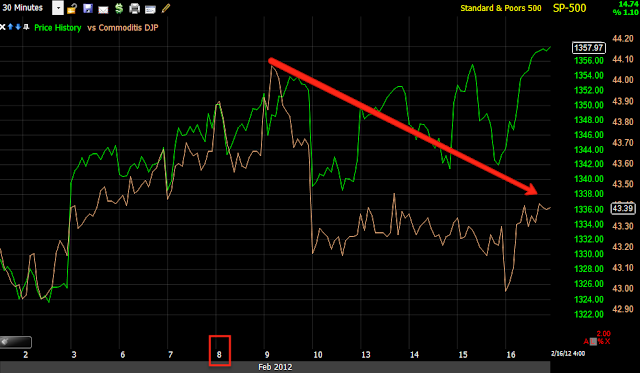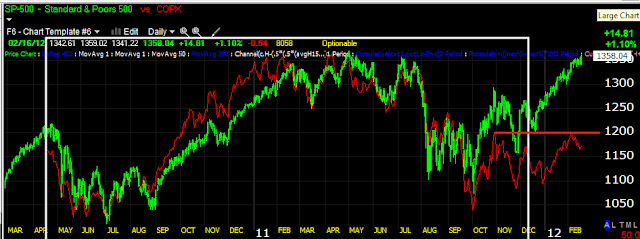It's been a long night, I just got in an hour or so ago and have been looking at the market. I have mentioned this week that European and US financials' credit has been underperforming the equities themselves and I saw this chart and immediately though, "This looks very familiar"
This shows US Financial stocks more or less range bound since early February, yet their Credit has been selling off hard since the 8th / 9th of February. It didn't take long to figure out why this chart looked so familiar, it was actually instant. You may wonder,"Why doe credit matter, we trade stocks?" The answer is because credit leads equities, it's one of the few leading indicators available and one that the majority of retail traders never bother to look at.
The reason it looks so familiar is that it is exactly what I showed you earlier today. We've been looking at the short term intraday Credit/Risk Asset indicators and the long term, but today I posted the intermediate term of the last week or so, around the same timeframe as the Financial Credit chart above.
Commodities as a risk asset have been selling off, they are much much further dislocated in the long term then this chart shows, but over the same period of time, there has been deleveraging in the commodity complex, the 8th is used as a reference point as that is about where we see financial credit selling off badly.
High Yield Credit hasn't made a higher high with the market since the 3rd and has also been selling off since, so not only financial Credit, but High Yield as well.
The Euro also has been selling off relative to the market over the same time period and despite today's very parabolic move, which I think is purely technical in nature based on the break of the important $1.30 level, the Euro remains in a downtrend on the week. We see it over and over again - a shakeout move after important support is broken. The Euro did this over a longer timeframe the first time $1.30 was broken and before it even bottomed, I said to expect a shake out move and then a move back below $1.30 and then to a new low, all of that happened ad this was before the Euro even hit bottom (for all anyone knew, it could have kept going), I said that at the time because we see this over and over again in every asset class.
The green arrow is Sunday's FX market open when the Euro gapped up, since then it has made lower high and lower lows, even with today's parabolic move (which almost always end bad), the downtrend is intact, but pay attention to the volatility right before the Euro broke $1.30 at the red trendline and then today's shakeout move, which still leaves this week's downtrend intact.
High Yield Corporate Credit in general (not just financial) has also failed to make a higher high since late January and has been divergent with the market in selling off, again, de-leveraging in the credit markets.
And financials in general have underperformed on a momentum basis a little longer then the financial credit sell-off, that's why that first chart looked so familiar. This is not an exercise of futility or curiosity, it is a leading indicator for equities; a bright red warning flag.
As for today's move, why some financial commentary attributes it to good economic data, it's hard to argue with this correlation and considering why the Euro bounced, I doubt very much this move had anything to do with economic data that wasn't all that important compared to more important data we have recently seen that hasn't produced a similar move. Options expiration tomorrow also can't be ignored.
This is the Euro today in orange vs. the SPX, the correlation is very similar. If the short term correlation is intact, there's no reason to believe that equities won't revert to the mean of the long term indications of a much lower Euro.
As for Price / Volume relationships for today, there was only one index that had a dominant P/V relationship, the Dow...
The relationship was extremely dominant at Close Up and Volume Down which is the most bearish of the 4 possible relationships, it was nearly 3:1 over the second place relationship.
Several days ago I noticed the Rate of Change in the SKEW was increasing again and started posting it nightly, tonight it's made another new high in this leg, as a reminder, the higher the CBOE's SKEW, the more probable an improbable event will occur, it might be called the "Black Swan Indicator" as higher levels indicate an increased probability of a market crash or Black Swan; it's an interesting indicator.
As for op-ex tomorrow, I took a quick look at the Call/Put open interest...
This is the Call chain for the SPY, note the open interest around in the money Calls...
Now look at the open interest in the Puts...
About 90% of options expire worthless, smart money tends to write them and pin them. A quick look at the open interest shows they'd have a lot more to lose if the market went down further today and into op-ex as the in the money Puts have very low open interest, but below that the open interest in much bigger then that of the calls so in pinning the most options, a decline in the market would certainly not be in their best interest.
The closing volume was interesting as well.
Volume was huge at the end of the day, but in to flat to slightly declining price action
It's not that hard to see momentum started to fade in the early afternoon, the ATR dropped nearly in half from the open to the close on a 15 min timeframe, meaning the range of each 15 min candle dropped significantly.
I was asked about Dr. Copper in n email tonight and some specific copper stocks so I took a look (It's called Dr. Copper because copper has been another traditional leading indicator for the market).
This is the long term copper index in red vs the SPX...
Look a little closer though and Copper is below it's August high, it's not leading the market, it's not even in line with the market. I looked at another measure, COPX.
Notice that COPX is divergent with the market and hasn't made a new high since October, this is the FIRST time since COPX was created that it has been divergent with the market. I'll cover the stocks in more detail tomorrow.
I mentioned this earlier in the week when talking about Dow Theory,
Dow Industrials vs the Dow Transports are diverging as well. While the Other major indices aren't diverging in this same manner, there is certainly a relative divergence between the NASDAQ primarily and the Russell 2000, Dow-30 and to a lesser degree the S&P-500. Again, Dow Theory is another leading indicator.
Skimming through the Dow Industrials, I was surprised at how many are just plain flat, but considering these are the blue chip, I was even more surprised to see how many look just plain bad, both on a relative basis compared to the Dow and on an individual basis.
AA
CVX
DE
JOY
KO
MCD
PFE
PG
T
TRV
VZ
XOM
Of course, only two of these are in the top 5 weighted Dow components and only 3 of them have a weight of 5-6%. If you want to move an index, you only need buy the top weighted stocks, but that's a breadth conversation that's a bit longer then I want to get in to tonight, suffice it to say, 22 of the 30 are underperforming notably the Dow itself, 2 are outperforming and the rest are in line, you could probably guess those that are outperforming or are in line are among the most heavily weighted components.
I won't bore you with all the charts, but XLF is severely underperforming a handful of the major money center banks, so a few of these banks are outperforming while financials as a whole are underperforming badly.
As of right now, bot ES and the EUR/USD are pretty much flat since the close, I suspect a pin tomorrow on op-ex considering the options chain charts above.
As of right now, futures are flat across the board for US averages.
Looking through the news tonight, the one interesting tidbit I dug up is that Germany is no openly talking about Greece leaving the Eurozone, which seemed to be the end game any way, that much has been pretty obvious. The problem however is that they are now talking about withholding their decision on the next tranche of aide until April (apparently after the Greek elections), this would put Greece in default as March 20th is when their debt payments come due, furthermore, there's talk that this will derail the debt negotiations (PSI) as the private creditors would want assurances of Troika involvement before agreeing to any deal.
Here's the story... and a few excerpts
German leaders openly discusss Greece leaving the Eurozone
Despite the latest agreement by Greek leaders with the troika of the IMF,EU,and ECB, the German Finance minister and other high ranking officials are openly discussing Greece leaving the Eurozone.
Now some members of the Eurozone including Germany, Finland and the Netherlands want to push the date for releasing the funds to April. Some Greeks see this as an interefernce into its democracy as elections are held in April and the Eurozone want parties that agreed to the bailout to prevail.
The plan to postpone the payment of the 14.5Billion euros will make it less likely that the private bondholders would want to agree to a haircut on its bonds if they are not assured of EU participation.
Is interest rates about to start going up?
-
Yes, I know - it does not make any sense - FED is about to cut
rates...but....real world interest rates are not always what FED wants it
to be.
6 years ago
































No comments:
Post a Comment